"It was a terrible, exhausting struggle on the ground and under the ground ..." The third assault on Stalingrad
V.G. Zaitsev
October 14 1942 of the year began the third, the most fierce, with the use of a large number of fire weapons, the assault on Stalingrad. The fierceness of the battle for the Soviet city reached its highest limit. The battles were fought for every quarter, lane, for every house, for every meter of land.
Third assault
October 14 1942, the year Adolf Hitler ordered his troops to switch to strategic defense on the entire Soviet-German front, except for the Stalingrad sector, as well as in the areas of Nalchik and Tuapse. Thus, in fact, the strategic plan for the war on 1942 year failed. The German armed forces could not destroy the main forces of the Red Army and defeat the Soviet Union. A protracted war of attrition began and all the brilliant successes of the Wehrmacht in 1942 could not change the overall situation. Germany, in fact, has already lost the war, although the Germans had no idea about it.
From a military point of view, it no longer mattered who would receive the ruins of Stalingrad. But the German high command still insisted on the capture of the city on the Volga. By mid-October 1942, the army of Paulus was preparing a new decisive assault. The enemy concentrated three infantry and two in the area of factories on a 5-kilometer stretch tank division, here he decided to strike a new blow. From all ends of the front, from the flanks, reinforcements, engineering and anti-tank units were drawn. From Germany, 5 sapper battalions were thrown over the air. In front of the front of the 62nd Army, 8 German divisions were replenished and prepared for battle, numbering 90 thousand soldiers and officers, with 2300 guns and 300 tanks. The 14th Panzer and 29th Motorized Divisions were withdrawn to the reserve. The assault was supposed to support the 8th air corps in full force. Chuikov’s army at that time had 55 thousand people, 1400 guns and mortars, and 80 tanks. And the 8th Air Army that supported it consisted of 188 serviceable combat aircraft.
Source: Samsonov A.M. The Battle of Stalingrad. M .: Science, 1989
At 8am on October 14th, after powerful raids aviation and artillery preparations, which lasted two and a half hours, the German ground forces went on the offensive, their main forces - three infantry and two tank divisions - rushed to the Volga on a 4-kilometer stretch between the Stalingrad Tractor Plant and the Barricades, trying to dismember the 62nd army and destroy it. There was not a single Soviet aircraft in the air. Chuikov phoned the commander of the 8th Air Army and “asked to calm down the fascist vultures a bit. General Khryukin said frankly that now there is nothing to help. The enemy tightly blocked the airfields of the army. It is not yet possible to break through our aircraft to Stalingrad ... That day we did not see the sun. "
German air raids, artillery and mortar shelling then continued until nightfall. The number of enemy sorties per day reached 3 thousand. The battle area was completely hidden by dust and smoke from breaks. The battle was accompanied by gigantic fires. The main attack of the Wehrmacht was in the general direction on the Tractor Plant and the Barricades factory, bringing it down to positions held by units of the 37 Guards, 95 and 308 rifle divisions and 84 tank brigade. On a narrow section of the front, where the 37-I Guards Rifle Division of General Zheludev was drained of the previous fierce battles, the enemy threw an infantry division of the whole and dozens of tanks.
It seemed that after a powerful bombardment from the air, as well as the most severe artillery and mortar shelling, the German army had crushed all life and now his troops would pass unhindered through the dead land filled with iron among the destroyed buildings. But the enemy again made a mistake in his calculations. Defenders of Stalingrad, skillfully taking advantage of engineering and natural shelters, the ruins of buildings, steadfastly held. The fight for the Tractor Works flared up with exceptional force. The fighting followed each house, floor, and landing. Between pos. Barricades and STZ separate houses and streets several times passed from hand to hand. The soldiers of the 37 th Guards, 95 th rifle divisions and other units of the 62 th army, hiding from fire in the trenches, among the ruins of destroyed houses, met the enemy with grenades, bottles of flammable liquid and small arms weapons. Calculations of artillery and anti-tank guns directly fire hit on enemy vehicles.
However, the inequality of forces was too great. After a fierce 4-hour battle, German troops broke through the defenses of the 37 Guards Rifle Division, crushed the left flank of the 112 Rifle Division and went to the STZ stadium. According to the 16 watch, according to the commander Chuikov, part of the 112 th, 37 th guards infantry divisions and the right flank of the 308 th rifle division, dismembered and bypassed by enemy tanks, fought in the environment. Scrambled to the last bullet. “The commander of the 37 division, General Zheludev, was bombarded from his bomber dam from the rupture of an aerial bomb. He was dug up by the soldiers from the guard of the army headquarters and led me into a dugout. The control of the units of his division took over the headquarters of the army. Information from the troops received contradictory, - recalled Chuykov. - It became harder and harder to refine them. The command and observation posts of the regiments and divisions were broken by shells and bombs. Many commanders died. At the command post of the army, 30 people died. The guard of the army headquarters did not have time to dig out people from broken dugouts. Troop control was carried out mainly by radio ... Surrounded and cut off garrisons continued to fight ... ".
The same fights were described by the author. stories German 14 Panzer Division - R. Grams. October 14, he notes, the division has achieved great success. Collected in a tight fist, supported by reinforced artillery and dive bombers, the division broke through the Tractor Plant and reached the 1 battalion of the 103 regiment and the tank battalion of the Volga coast in the northern part of the city around midnight. But it was more difficult to keep the captured territories. Grams quite expressively describes the terrible picture of the battle: “It was a terrible, exhausting struggle on the ground and under the ground, in ruins and basements, in the ditches of a big city, in its industrial quarters ... Tanks clambered through mountains of debris and debris, scraping their way through monstrously destroyed factory shops, shot from close distances along the streets littered and close factory yards. Another armored colossus suddenly shook and torn to pieces under the din of a detonating enemy mine. But all this could still be endured. Further, there was a deep, as a bottomless gorge, the Volga bank abruptly cutting off towards the river, the fiercest battles flared up here. ” On the seemingly already occupied territory, at night on the flanks and in the rear of all the cracks and cracks of the earth appeared Soviet soldiers. “And everything that was conquered in the evening in the hot fight, by the morning was again lost. And on the opposite lowland wooded bank of the river it was impossible to see the enemy, his batteries were invisible, his infantry was there, but he was there, he fired artillery fire from there, and every night hundreds of his boats transported reinforcements through a wide stream into the ruins of Stalingrad, and everything began first: hurricane fire, dive-bombers, smoke and chad, which covered the sun for hours. But the situation remained almost unchanged, and the fighting capacity of our troops melted like butter in the sun. ”
Especially heavy battles of October 14 were in the defense line of the 37 Guards Rifle Division and the 90 Rifle Regiment of the 95 Rifle Division, covering the approaches to the Tractor Plant. German 389 and 94 I infantry, 100 Ieger (light infantry), 14 I and 24 I tank divisions attacked here. The Germans threw a strong armored group into the attack. Each attack was preceded by a strong artillery preparation and massive air strikes. The Luftwaffe made X-NUMX-800 sorties during the day. After powerful artillery and air strikes, two or three echelons of tanks followed the infantry, followed by infantry. By evening, the enemy broke into the territory of the Tractor Plant, and then, deepening the breakthrough, the assault detachments reached the Volga. The head of the army headquarters, General Krylov, believed that “the position of the army was never so difficult,” it was very close to complete destruction. The right flank of the Soviet army was cut off from the main forces north of r. Wet Mecheka. The cut-off group (about 900 thousand soldiers), led by the commander of the 7 rifle brigade, Colonel S. F. Gorokhov, occupied the all-round defense in the Rynok, Spartanovka area. The Gorokhov group, supplied with air ammunition, for more than a month, seized by the enemy from three sides and pressed against the Volga, continued to stand firmly in defense.
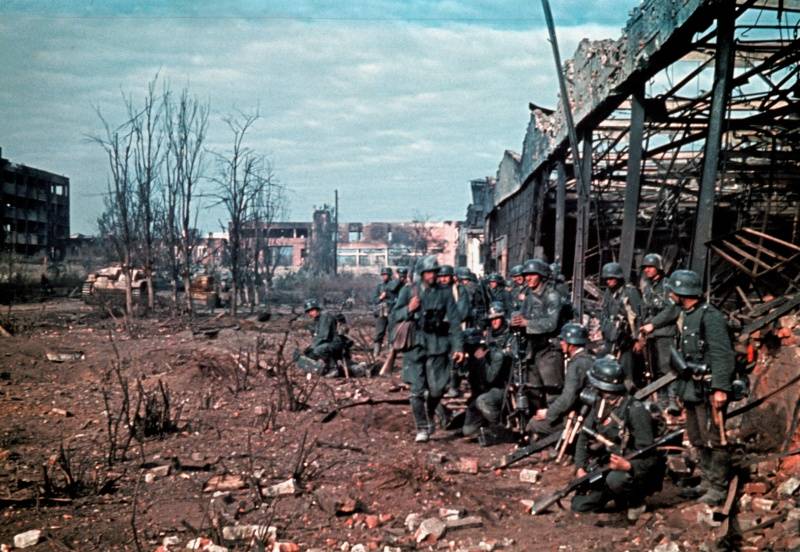
Soldiers of the 9 Company under the command of Lieutenant Klaus Vogt of the 578 Infantry Regiment of the 305 Infantry Division of the Wehrmacht at the ruins of the Stalingrad Tractor Plant

German self-propelled guns StuG III at the ruins of the Stalingrad Tractor Plant
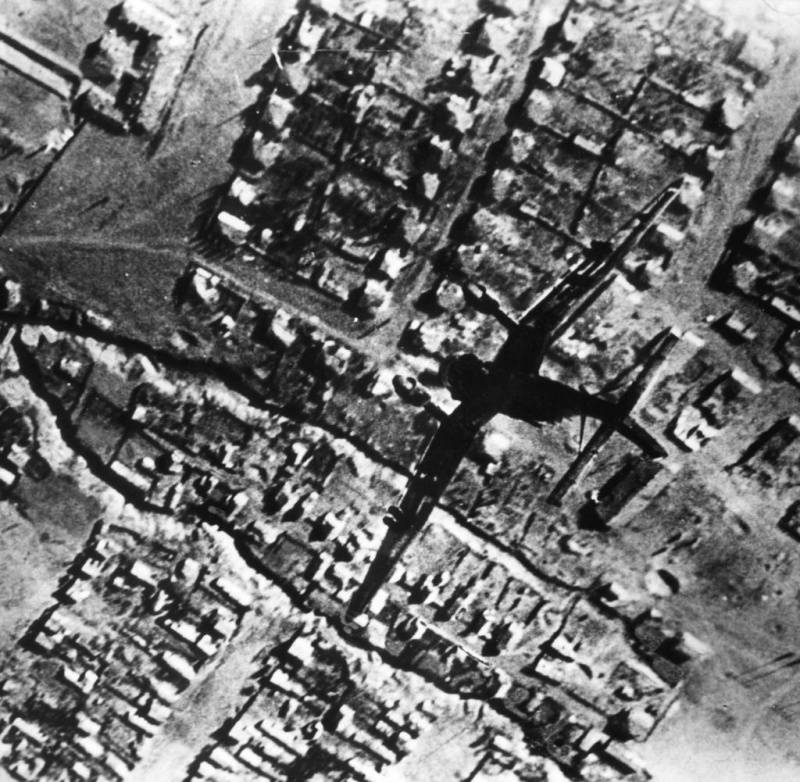
Luftwaffe dive bomber U-87 comes to the target during the fighting in Stalingrad
October 15 continued stubborn fighting in the area of the FCZ and the northern sector of the front 62 th army. The enemy entered the 305 Infantry Division into battle and sought to develop an offensive south and north along the Volga in order to go into the rear of the main forces of the Soviet army and completely destroy them. German artillery and aircraft inflicted continuous strikes on the combat formations of the Soviet troops. Enemy fighters still dominated the air. The main blow fell on the 37-th Guards Division. Guardsmen continued to fight with separate divisions in the village of STZ and part of the forces in the area of Minusinskaya Street. The Guards Division in these battles was almost completely killed, defending the Tractor Plant to the end. The regimental artillery, 45-mm guns, mortars and anti-tank guns were completely destroyed in the battles. Heavy battles were also 95-I Rifle Division and 84-I tank brigade. Fighting went to 500 m from the command post of the army. Another enemy group attacked parts of the 124 and 149 rifle brigades from two directions on the same day: from the north to the Market and from the west to the village of Spartanovka. The Germans managed to wedge a bit between these brigades.
The command of the Stalingrad Front tried to support the army of Chuikov. By the end of October 14, the 138 Rifle Division from the 64 Army was transferred to the command of the 62 Army commander. Colonel I. I. Lyudnikov was ordered to immediately raise an entire rifle regiment in full force and, no later than the morning of October 15, to ship to the western bank of the Volga. However, the enemy led an intensified fire on all moorings and ferries, and on that day the ferry could not be organized. The 138 th regiment of the rifle division Colonel Lyudnikov managed to ship to Stalingrad on the night of October 16, and the fighters immediately fought north of the Barricades factory.
October 16 German troops continued the assault, trying to defeat the main forces of the 62 th army. The 389-I infantry and 16-I tank enemy divisions in the morning attacked the group of Colonel Gorokhov, who defended the villages of Rynok and Spartanovka. At the same time, units of the German 305, 100, 94 and infantry and 14, 24 armored divisions continued to advance south along the right bank of the Volga. The onslaught of the German divisions was resisted to the utmost by the exsanguinated units of the 37 th Guards and 95 th rifle divisions (in the divisions left over the weakened company) and the regiment of the 138 th rifle division with the 84 th tank brigade. Our troops from the last forces repelled the enemy attacks. And they would not have survived, but at the most critical moment the Chuikov army was supported by assault aircraft and army and front artillery from the left bank of the Volga.
In order to prevent the enemy from surrounding and completely destroying the remnants of the 37 th Guards and 95 th rifle divisions, they were relegated closer to the Barricades factory. On the night of October 17, the rest of the 138 Infantry Division crossed to the right bank. October 17 stubborn fighting continued. Particularly fierce battles were in the area of the plant "Red October" village. Market and north of the plant STZ, where in isolation from the main forces of the army defended the group of Colonel Gorokhov. German troops tried to crush a separate group of Soviet troops and repeatedly attacked it. However, the Soviet soldiers repelled the enemy attacks and counterattacked themselves.
Fierce fighting continued in the area of the Barricades factory. Having penetrated between the 138 and 308 rifle divisions, the enemy deployed an offensive along the railroad to the plant. The commander of the 62 army ordered the commander of the 138 rifle division, Colonel Lyudnikov, to close the gap with the 308 rifle division. On October 18, German troops, breaking through the battle formations of the 308 Infantry Division, reached the western edge of the Barricades factory. The Germans tried to completely seize the plant and reach the Volga in the area of the ferry No. 62. Our troops repelled the fierce attacks of the enemy.
On October 19, the enemy conducted strong artillery and mortar fire on the Barricades and Red October factories and at the mouth of the Banny ravine. At the same time, the Germans tried to destroy the group of Gorokhov.
Thus, the defenders of Stalingrad withstood another terrible blow of the enemy and continued the struggle. In the hands of the Germans were Mamaev Kurgan, height 107,5, outputs to the Volga in the area of the STZ and near the mouth of the river. The Queen. The territory occupied by the 62 Army was completely swept by enemy artillery and mortars, and in some places by machine-gun and machine-gun fire. All city buildings were destroyed by German aircraft. Continued strong fires. However, the situation has changed. The most critical days of the struggle for Stalingrad left behind. In the battles of 14-18 of October, German troops were finally exhausted, drained of blood.
The enemy managed to seize the Tractor Plant, to penetrate here in the defense of the Soviet troops and go to the Volga. The front of the 62 Army was broken up again. But the enemy and this time did not achieve decisive success, failed to break the resistance of the defenders of the city. At the same time, the force of the blows of the enemy, his offensive energy began to fade. The Wehrmacht could not dump the remnants of the army of Chuikov in the Volga. In addition, it is regularly strengthened.
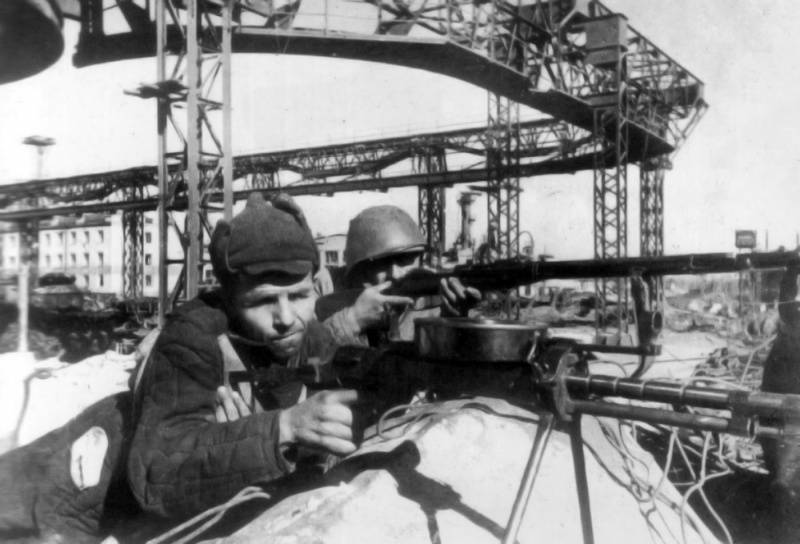
The workers of the Stalingrad Tractor Plant (STZ), bricklayer I.Ilyushin and unskilled laborer M.Shumilin defending their plant against the advancing German forces. The fighter in the foreground is armed with a tank gun Dygtereva (DT), which was installed on the factory produced tanks T-34. Photo source: http://waralbum.ru/
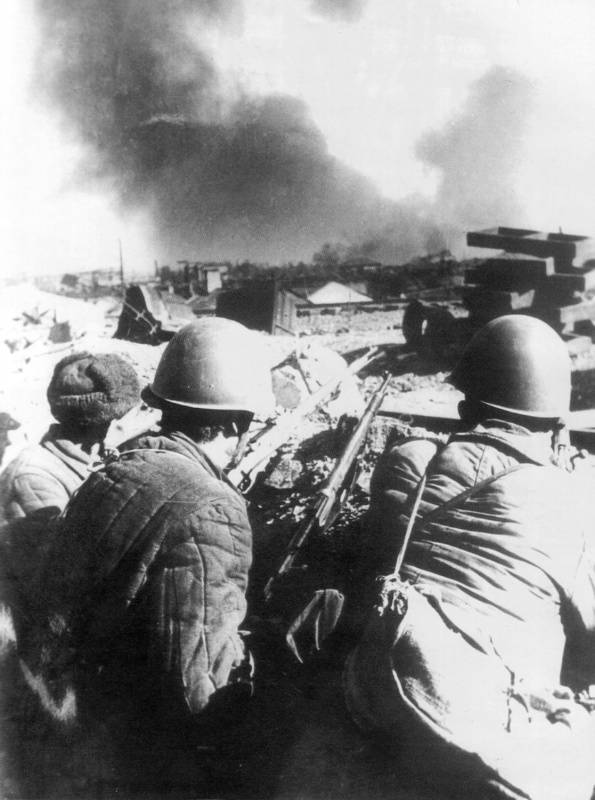
The workers of the plant "Red October" to protect the native plant
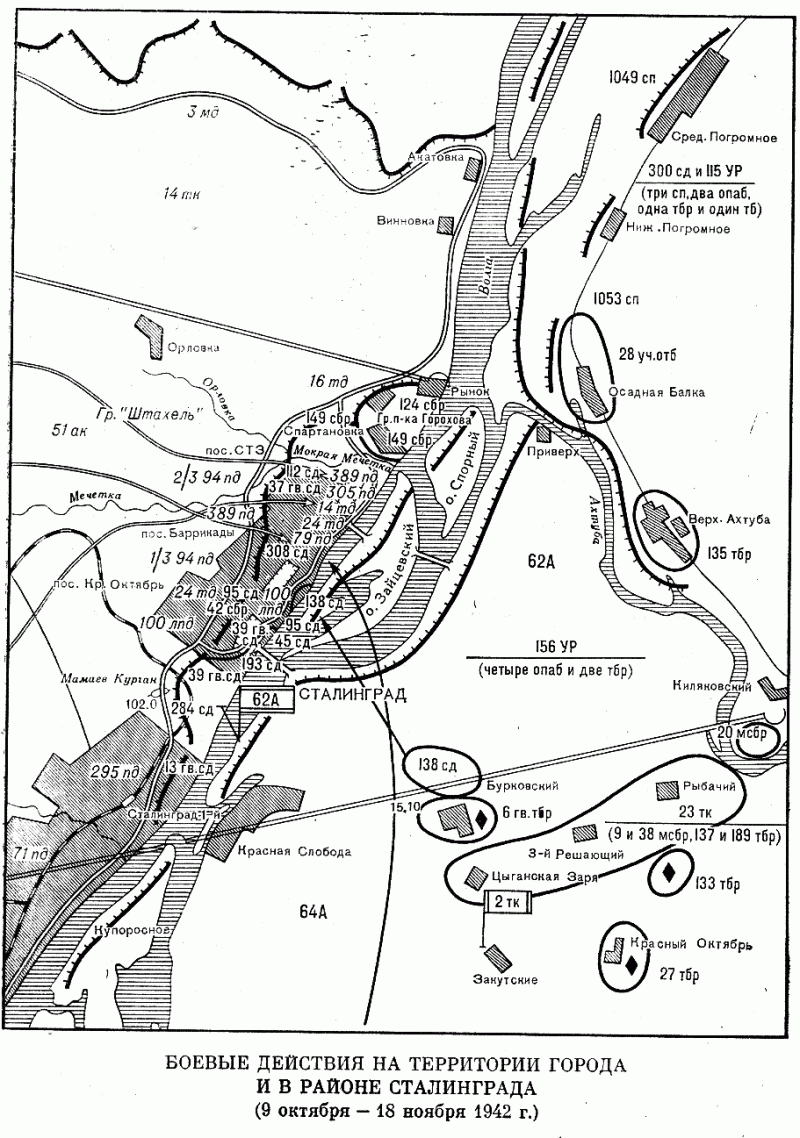
Information